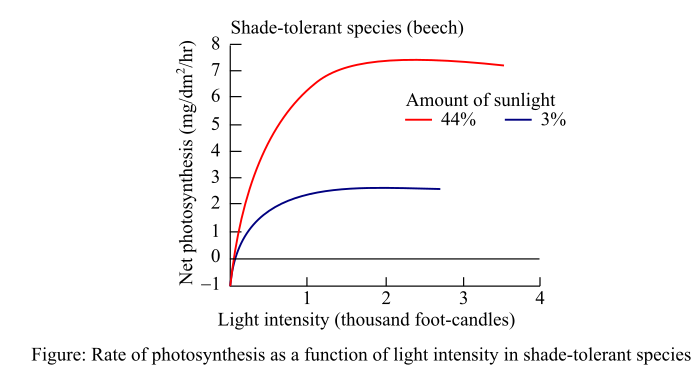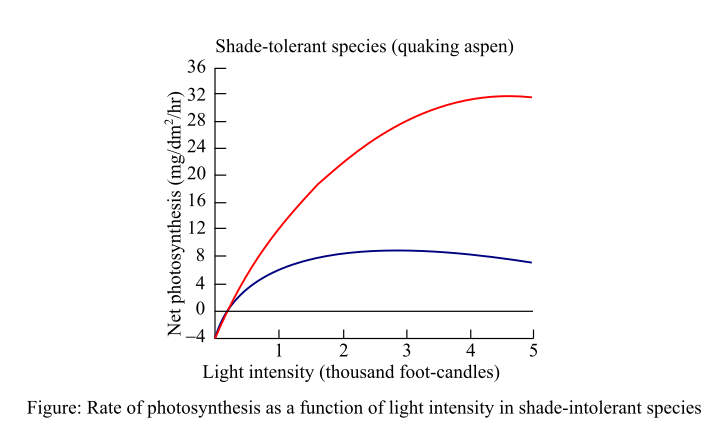
Life: The Science of Biology
11th Edition
ISBN: 9781319010164
Author: David E. Sadava, David M. Hillis, H. Craig Heller, Sally D. Hacker
Publisher: W. H. Freeman
expand_more
expand_more
format_list_bulleted
Concept explainers
Question
Chapter 10, Problem 2Q
Summary Introduction
To review:
The difference in the rate of photosynthesis in shade-tolerant and shade-intolerant plants, and the reason for this difference.
Given:
The graphs representing the rate of photosynthesis as a function of the intensity of light are given below:


Introduction:
A shade-tolerant and a shade-intolerant plant were allowed to grow by 3% and 44% daylight conditions. After approximately 5 weeks, a leaf from both the plants was exposed to different light intensities and the rate of photosynthesis in its cells was measured.
Expert Solution & Answer
Want to see the full answer?
Check out a sample textbook solution
Students have asked these similar questions
Discuss other morphological differences between sunny and shady set-ups of mung bean in relation to phototropic response of plants.
Characteristics
sunny
shaded
Leaf color
Lime Green
Pale Green
Direction of Growth
Grows upward towards the direction of sunlight
Oriented in the direction of the light but growth is bent downward
Would a red:FR light value of 0.14 1:7 be expected of a plant in shaded light beneath a leaf canopy and if we assume that ratio would we expect that our pfr per total phytochromes would be more than that in direct sunlight?
In hot, dry climates, plants have evolved mechanisms to avoid photorespiration. Which of the following is FALSE
Select an answer and submit. For keyboard navigation, use the up/down arrow keys to select an answer.
a
b
с
d
C3 plants have no mechanism to avoid photorespiration
C4 plants reduce photorespiration by separating the light reaction in the mesophyll cells from the light-
independent reaction in the bundle-sheath cells
CAM plants minimize photorespiration by collecting and storing CO2 at night and keeping their stomata
closed during the day
C4 plants include corn, sugarcane, and many grasses
CAM plants can undergo photophosphorylation in the absence of sunlight
7
Open in Readin
Chapter 10 Solutions
Life: The Science of Biology
Knowledge Booster
Learn more about
Need a deep-dive on the concept behind this application? Look no further. Learn more about this topic, biology and related others by exploring similar questions and additional content below.Similar questions
- In hot, dry climates, plants have evolved mechanisms to avoid photorespiration. Which of the following is FALSE Select an answer and submit. For keyboard navigation, use the up/down arrow keys to select an answer. a b с d e C3 plants have no mechanism to avoid photorespiration C4 plants reduce photorespiration by separating the light reaction in the mesophyll cells from the light- independent reaction in the bundle-sheath cells CAM plants minimize photorespiration by collecting and storing CO2 at night and keeping their stomata closed during the day C4 plants include corn, sugarcane, and many grasses CAM plants can undergo photophosphorylation in the absence of sunlight Open in Readirarrow_forwardA team of researchers investigated the effects of phosphorous availability and light intensity on an angiosperm species. Seeds of the angiosperm were divided into four equal groups. Groups 1 and 2 were exposed to 200 μmol, and Groups 3 and 4 were exposed to 500 μmol. Groups 2 and 4 also received a phosphorous (P) solution. After 20 days, all plants were weighed, and the average dry weight of each group was calculated. The results are in the table below. Group 1(200 μmol, no P) Group 2(200 μmol, + P) Group 3 (500 μmol, no P) Group 4 (500 μmol + P) Average Dry weight (g) 0.8 1.1 1.5 6.2 Describe the effects of light and phosphorous on the growth of the plants in this study. Explain how the metabolic processes associated with the plant kingdom likely influenced these results.arrow_forwardA team of researchers investigated the effects of phosphorous availability and light intensity on an angiosperm species. Seeds of the angiosperm were divided into four equal groups. Groups 1 and 2 were exposed to 200 pmol, and Groups 3 and 4 were exposed to 500 umol. Groups 2 and 4 also received a phosphorous (P) solution. After 20 days, all plants were weighed, and the average dry weight of each group was calculated. The results are in the table below. Group 1(200 pmol, Group 2(200 umol, Group 3 (500 umol, Group 4 (500 pmol no P) no P) +P) Average Dry weight (g) Describe the effects of light and phosphorous on the growth of the plants in this study. Explain how the metabolic processes associated with the plant kingdom likely influenced these results. 10.8 1.5 6.2arrow_forward
- In a set-up where Plant 1 and Plant 2 are exposed to light, Plant 1 had a transpiration rate of 1.24 while Plant 2 had a transpiration rate of 1.01. If your goal is to conserve water, which plant is better to be planted during summer wherein there s a high solar incidence?arrow_forwarddiscussmorphological differences between sunny and shady setups of mung beans in relation to phototropic response of plantsarrow_forwardHow does skunk cabbage heat its inflorescence? What advantages does skunk cabbage derive from this adaptation? How may this impact other species? Would you classify this plant and ecothermal and explain your answer. (Minimum 200 words.)arrow_forward
- The data that is attached below was collected during a lettuce seed ecotoxicity assay. Lettuce seed assays are used to compare the ecotoxicity of methanol, ethanol, and isopropanol by these alcohols' effects on germination rate and root elongination. Using the attached data, help answer which alcohol seems to be the most toxic to lettuce seeds. Why or why not would your results be expected? What does this information tell you about using ecotoxicity data to estimate human toxicity?arrow_forwardOne similarity about the chlorophyll content between the low and moderate light seedlings is: A. Both seedling groups have about the same amount of chlorophyll content for the first 12 hours of growth. B. Both seedling groups have the exact same amount of chlorophyll content for the first 8 hours of growth. C. Both seedling groups have the exact same amount of chlorophyll content for the first 3 to 5 hours of growth. D. Both seedling groups have the exact same amount of chlorophyll content for the last 24 hours of growth.arrow_forwardTRUE OR FALSE Rice varieties with erectophile leaves are more susceptible to photorespiration compared to those with planophile leaves.arrow_forward
- An angiosperm called “ghost plant” does not produce chlorophyll orother photosynthetic pigments and is almost completely white. Basedonly on this information, what assumptions can you make about ghostplants?arrow_forwardWhich phytochrome is sensing the shading and what are the TWO (2) rapid shade avoiding responses? *arrow_forwardWatch the suggested videos for Plants Response to Stimuli. a. GeotropismGeotropism Experiment (2:48 minutes)https://www.youtube.com/watch?v=AEo5UsPeB5gb. PhototropismPhototropism Experiment (2:16 minutes)https://www.youtube.com/watch?v=WZ1NRP3OF5w a. For each experimental set up (geotropism and phototropism), identify the dependent and independent variables that have contributed to how plants responded to the stimuli.arrow_forward
arrow_back_ios
SEE MORE QUESTIONS
arrow_forward_ios
Recommended textbooks for you
 Biology (MindTap Course List)BiologyISBN:9781337392938Author:Eldra Solomon, Charles Martin, Diana W. Martin, Linda R. BergPublisher:Cengage Learning
Biology (MindTap Course List)BiologyISBN:9781337392938Author:Eldra Solomon, Charles Martin, Diana W. Martin, Linda R. BergPublisher:Cengage Learning Biology: The Dynamic Science (MindTap Course List)BiologyISBN:9781305389892Author:Peter J. Russell, Paul E. Hertz, Beverly McMillanPublisher:Cengage Learning
Biology: The Dynamic Science (MindTap Course List)BiologyISBN:9781305389892Author:Peter J. Russell, Paul E. Hertz, Beverly McMillanPublisher:Cengage Learning

Biology (MindTap Course List)
Biology
ISBN:9781337392938
Author:Eldra Solomon, Charles Martin, Diana W. Martin, Linda R. Berg
Publisher:Cengage Learning

Biology: The Dynamic Science (MindTap Course List)
Biology
ISBN:9781305389892
Author:Peter J. Russell, Paul E. Hertz, Beverly McMillan
Publisher:Cengage Learning